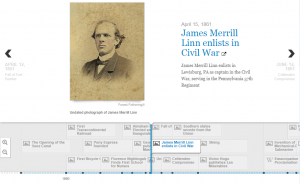Representing historical events in a written form can be a difficult process. Writing is a medium that, once created, is unchanging, so the information needs to be represented in some way that can still show change and time. We do this by manipulating space. Grafton pointed out in his writing that traditional clocks trace time as a circle, and even when we look at a digital clock, we translate the numbers that we see into a line of the time in a day.
The same process happens with the longer-scale time of history as well. It’s difficult to understand history by simply interpreting words on a page, so we translate the words into events and visualize those in space. Commonly, those events go on a timeline. Timelines are good at showing proximity and distance between events, and revealing patterns over time.
In our Timemapper timeline, we constructed a database of historical events that surround  the time when Linn was writing his diary. The creation and study of our completed timeline made me realize a few things. For example, it’s very easy to get wrapped up in a particular set of events. As a result, it can be difficult to recognize, or pay significant mind to, larger events going on around the same time. When reading Linn’s diary, I found myself forgetting that he was writing about events in a small corner of the Civil War. Opening up the scale and comparing his story to the rest of history really put his story into perspective. The scale of a historical graphic really depends on how detailed you make it, represented well by the annals from the 700s in Grafton’s essay.
the time when Linn was writing his diary. The creation and study of our completed timeline made me realize a few things. For example, it’s very easy to get wrapped up in a particular set of events. As a result, it can be difficult to recognize, or pay significant mind to, larger events going on around the same time. When reading Linn’s diary, I found myself forgetting that he was writing about events in a small corner of the Civil War. Opening up the scale and comparing his story to the rest of history really put his story into perspective. The scale of a historical graphic really depends on how detailed you make it, represented well by the annals from the 700s in Grafton’s essay.
Timemapper also revealed how independent history and different parts of the world can be. While the Civil War was going on, life in the rest of the world went on as normal. Even in many parts of the United States, major events happened that had nothing to do with the war. This ties in with my previous observation, and helps to explain Linn’s writing. Human history is a collection of the stories of individuals who move around, who make and lose connections. It’s impossible to represent such a complicated system in a definitive, single-stream way.

One reply on “Blog III: Representing Time with Space”
I noticed you said, “While the Civil War was going on, life in the rest of the world went on as normal.” I have often considered this and partly touched on this as the telecommunications developments of the 1860s. In my post I noted how technologies and structures like the intercontinental railroad and the transatlantic telegraph cable made it more difficult to be isolated from distant events. I wonder just how normal life was maintained after the beginning of the Civil War. For more recent history like WWII and WWI, I know that normal everyday life changed dramatically, with war rations and demographic changes. The everyday life an interesting study of history regardless, where single events dominate the narrative.